
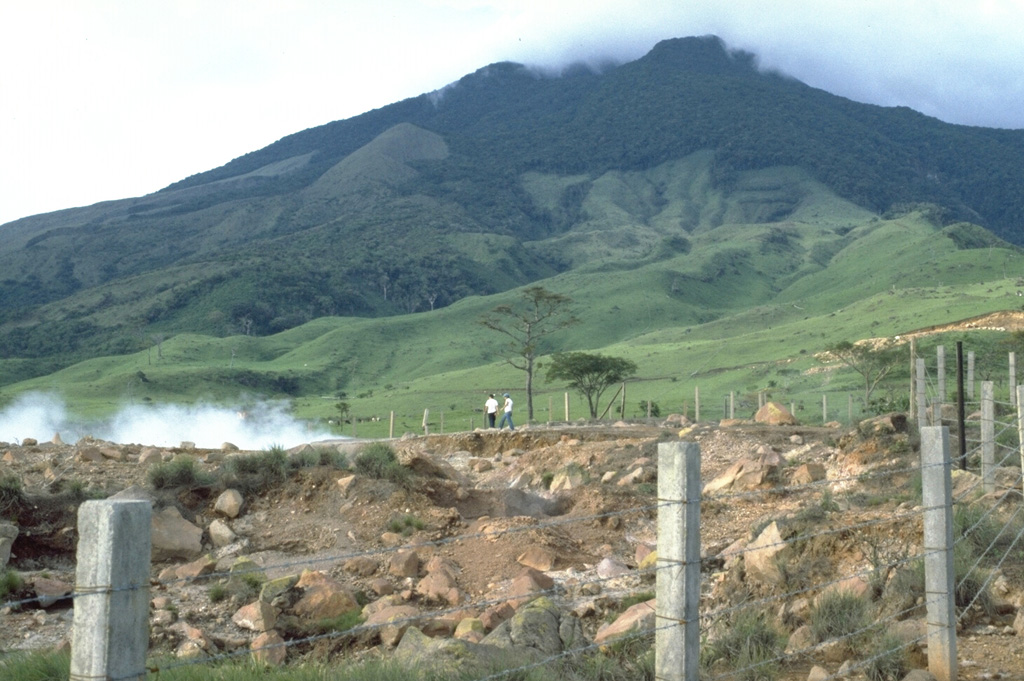
Significant earthquake swarm under S flank
The most significant earthquake swarm at Miravalles in several years occurred on the S flank during 5-27 October (figure 2). The swarm, consisting of 146 located events, was centered around 10.7°N, 85.15°W. No pattern was found correlating the seismity with known local faults.
Approximately 88% of the earthquakes were M5.0 are not rare near Miravalles; however, the occurrence of two unrelated swarms nearby at Tenorio (~16 km ESE) during October was unusual.
Information Contacts: Gerardo J. Soto and Waldo Taylor, Oficina de Sismología y Vulcanología, Departamento de Geología, Instituto Costarricense de Electricidad (ICE), Apartado 10032-1000, San José, Costa Rica.
The Global Volcanism Program has no Weekly Reports available for Miravalles.
Reports are organized chronologically and indexed below by Month/Year (Publication Volume:Number), and include a one-line summary. Click on the index link or scroll down to read the reports.
Summary of April 1991-July 1994 seismicity
"The Office of Seismology and Volcanology of the Department of Geological Engineering, Costa Rican Institute of Electricity (ICE), has monitored the seismicity of the Miravalles Geothermal Field since 1977. The monthly number of recorded earthquakes at the Miravalles Caldera from April 1991 through July 1994 is shown on figure 1. Maximum magnitudes were 3.5; no high-magnitude local earthquakes occurred within the geothermal field during this study period. Previous seismological campaigns showed a similar level of activity.
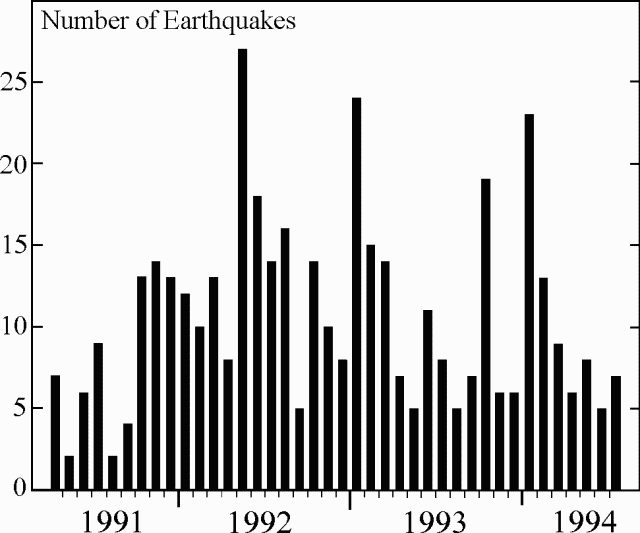 |
Figure 1. Monthly number of earthquakes recorded within the Miravalles Caldera, April 1991-July 1994. Courtesy of R. Barquero, ICE. |
"The 219 tectonic events located during this period were distributed within a radius of 15 km of the geothermal field. There were some clusters of events that from their location and alignment could be correlated to previously determined faults and structures in the area and they were cataloged in 8 groups. Earthquakes recorded during the monitoring campaign were mostly shallow, with depths of 0-15 km and predominantly 0-5 km. The distribution of earthquakes cannot be correlated with a magma chamber or any shallow magmatic body in the area, but it confirms that some seismic activity is taking place under and inside the caldera."
Information Contacts: R. Barquero, ICE.
Significant earthquake swarm under S flank
The most significant earthquake swarm at Miravalles in several years occurred on the S flank during 5-27 October (figure 2). The swarm, consisting of 146 located events, was centered around 10.7°N, 85.15°W. No pattern was found correlating the seismity with known local faults.
Approximately 88% of the earthquakes were M5.0 are not rare near Miravalles; however, the occurrence of two unrelated swarms nearby at Tenorio (~16 km ESE) during October was unusual.
Information Contacts: Gerardo J. Soto and Waldo Taylor, Oficina de Sismología y Vulcanología, Departamento de Geología, Instituto Costarricense de Electricidad (ICE), Apartado 10032-1000, San José, Costa Rica.
|
|
||||||||||||||||||||||||||
There is data available for 2 confirmed Holocene eruptive periods.
1946 Sep 14 - 1946 Sep 14 Confirmed Eruption (Explosive / Effusive) VEI: 1
| Episode 1 | Eruption (Explosive / Effusive) | SW flank (near Las Hornillas) | |||||||||||||||||||||||||||||
|---|---|---|---|---|---|---|---|---|---|---|---|---|---|---|---|---|---|---|---|---|---|---|---|---|---|---|---|---|---|---|
| 1946 Sep 14 - 1946 Sep 14 | Evidence from Observations: Reported | |||||||||||||||||||||||||||||
|
List of 4 Events for Episode 1 at SW flank (near Las Hornillas)
|
||||||||||||||||||||||||||||||
5050 BCE (?) Confirmed Eruption (Explosive / Effusive)
| Episode 1 | Eruption (Explosive / Effusive) | |||||||||||||||
|---|---|---|---|---|---|---|---|---|---|---|---|---|---|---|---|
| 5050 BCE (?) - Unknown | Evidence from Correlation: Tephrochronology | ||||||||||||||
|
List of 1 Events for Episode 1
|
|||||||||||||||
This compilation of synonyms and subsidiary features may not be comprehensive. Features are organized into four major categories: Cones, Craters, Domes, and Thermal Features. Synonyms of features appear indented below the primary name. In some cases additional feature type, elevation, or location details are provided.
Synonyms |
||||
| Cuipilapa | ||||
Cones |
||||
| Feature Name | Feature Type | Elevation | Latitude | Longitude |
| Cabro Muco-La Giganta | Stratovolcano | |||
| Espíritu Santo | Stratovolcano | |||
| Mogote, Cerro | Stratovolcano | |||
| Montanosa, Cerro la | Stratovolcano | |||
| Santa María | Stratovolcano | |||
Craters |
||||
| Feature Name | Feature Type | Elevation | Latitude | Longitude |
| Guayabo | Pleistocene caldera | |||
Thermal |
||||
| Feature Name | Feature Type | Elevation | Latitude | Longitude |
| Hornillas, Las | Thermal | |||
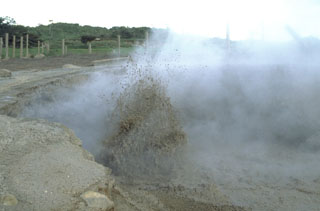 Vigorous mud eruptions occur at Las Hornillos thermal area on the W flank of Costa Rica's Miravalles volcano. A geothermal project in the 15 x 20 km Guayabo caldera (containing Miravalles) provides a major component of the electrical power needs of Costa Rica.
Vigorous mud eruptions occur at Las Hornillos thermal area on the W flank of Costa Rica's Miravalles volcano. A geothermal project in the 15 x 20 km Guayabo caldera (containing Miravalles) provides a major component of the electrical power needs of Costa Rica.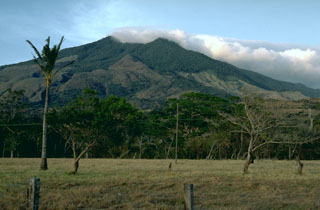 Miravalles, seen here looking NE from the Guayabo caldera floor, is the youngest feature of the volcanic complex. Multiple edifices have grown in the eastern part of the 15 x 20 km caldera, which formed sometime between 1.5 million and 600,000 years ago.
Miravalles, seen here looking NE from the Guayabo caldera floor, is the youngest feature of the volcanic complex. Multiple edifices have grown in the eastern part of the 15 x 20 km caldera, which formed sometime between 1.5 million and 600,000 years ago. A geothermal area is seen here on the Miravalles SW flank in 1988. The edifice is one of five post-caldera cones constructed within the Pleistocene Guayabo caldera. Lava flows cover the W and SW flanks. A small steam explosion was reported in 1946 and a producing geothermal field is located within the caldera.
A geothermal area is seen here on the Miravalles SW flank in 1988. The edifice is one of five post-caldera cones constructed within the Pleistocene Guayabo caldera. Lava flows cover the W and SW flanks. A small steam explosion was reported in 1946 and a producing geothermal field is located within the caldera.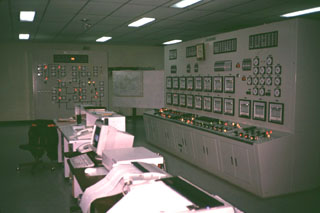 Electrical power from the Miravalles geothermal plant is distributed from the control room of Project CORTEZ. The Miravalles I and II wells produce 60 and 55 MW of power, respectively, through reinjection. The vapor-phase Miravalles III well is expected to produce 27.5 MW. The depths of the geothermal wells vary from 959 to 3022 m.
Electrical power from the Miravalles geothermal plant is distributed from the control room of Project CORTEZ. The Miravalles I and II wells produce 60 and 55 MW of power, respectively, through reinjection. The vapor-phase Miravalles III well is expected to produce 27.5 MW. The depths of the geothermal wells vary from 959 to 3022 m.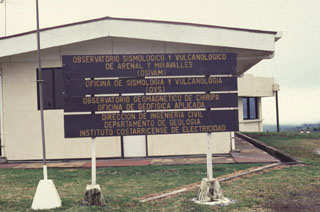 This is the OSIVAM observatory that monitors seismic and volcanic activity at Arenal and Miravalles volcanoes. The observatory is located in Quebrada Grande, 14 km from the town of Tilarán and west of Lake Arenal.
This is the OSIVAM observatory that monitors seismic and volcanic activity at Arenal and Miravalles volcanoes. The observatory is located in Quebrada Grande, 14 km from the town of Tilarán and west of Lake Arenal.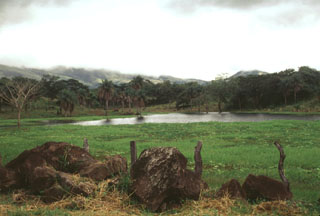 This topography south of Miravalles volcano is typical of that resulting from large volcanic debris avalanches and represents material produced by major edifice collapse. Large boulders are abundant, such as those in the foreground.
This topography south of Miravalles volcano is typical of that resulting from large volcanic debris avalanches and represents material produced by major edifice collapse. Large boulders are abundant, such as those in the foreground. 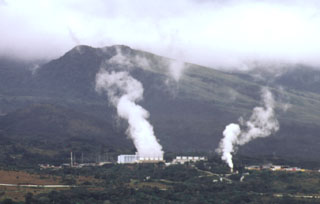 Steam plumes rise from power plants of the Miravalles geothermal project in 1998, which began production in 1994.
Steam plumes rise from power plants of the Miravalles geothermal project in 1998, which began production in 1994.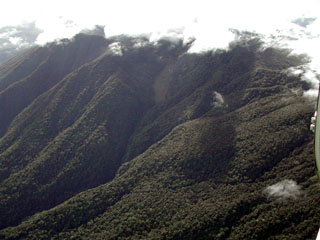 The remote northern side of the youngest cone of the Miravalles volcanic complex is covered with dense rain forest. Prior to the arrival of the Spanish, Miravalles was known by indigenous people as Cuipilapa, a Nahuatl term meaning "river of many colors," a reference to minerals dissolved in rivers descending the volcano.
The remote northern side of the youngest cone of the Miravalles volcanic complex is covered with dense rain forest. Prior to the arrival of the Spanish, Miravalles was known by indigenous people as Cuipilapa, a Nahuatl term meaning "river of many colors," a reference to minerals dissolved in rivers descending the volcano. The following 34 samples associated with this volcano can be found in the Smithsonian's NMNH Department of Mineral Sciences collections, and may be availble for research (contact the Rock and Ore Collections Manager). Catalog number links will open a window with more information.
| Catalog Number | Sample Description | Lava Source | Collection Date |
|---|---|---|---|
| NMNH 116066-173 | Tephra | -- | 6 Mar 1985 |
| NMNH 116066-175 | Biotite Ignimbrite | -- | 6 Mar 1985 |
| NMNH 116066-176 | Tephra | -- | 6 Mar 1985 |
| NMNH 116066-177 | Tephra | -- | 6 Mar 1985 |
| NMNH 116066-178 | Tephra | -- | 6 Mar 1985 |
| NMNH 116066-179 | Tephra | -- | 6 Mar 1985 |
| NMNH 116066-180 | Tephra | -- | 6 Mar 1985 |
| NMNH 116066-181 | Tephra | -- | 6 Mar 1985 |
| NMNH 116066-182 | Tephra | -- | 6 Mar 1985 |
| NMNH 116066-183 | Tephra | -- | 6 Mar 1985 |
| NMNH 116066-184 | Tephra | -- | 6 Mar 1985 |
| NMNH 116066-185 | Tephra | -- | 6 Mar 1985 |
| NMNH 116066-186 | Tephra | -- | 6 Mar 1985 |
| NMNH 116066-188 | Tephra | -- | 6 Mar 1985 |
| NMNH 116066-189 | Tephra | -- | 6 Mar 1985 |
| NMNH 116066-190 | Tephra | -- | 6 Mar 1985 |
| NMNH 116066-192 | Tephra | -- | 6 Mar 1985 |
| NMNH 116066-193 | Tephra | -- | 6 Mar 1985 |
| NMNH 116066-194 | Andesite | -- | 6 Mar 1985 |
| NMNH 116066-322 | Basaltic Andesite | -- | 15 Mar 1985 |
| NMNH 116066-324 | Vitrophyre | -- | 15 Mar 1985 |
| NMNH 116066-326 | Ignimbrite | -- | 15 Mar 1985 |
| NMNH 116066-329 | Ignimbrite | -- | 15 Mar 1985 |
| NMNH 116066-330 | Xenolith | -- | 15 Mar 1985 |
| NMNH 116066-376 | Pumice | -- | -- |
| NMNH 116066-377 | Volcanic Debris | -- | -- |
| NMNH 116066-378 | Pumice | -- | -- |
| NMNH 116066-379 | Volcanic Rock | -- | 21 Apr 1985 |
| NMNH 116066-381 | Unidentified | -- | 21 Apr 1985 |
| NMNH 116066-382 | Unidentified | -- | 21 Apr 1985 |
| NMNH 116066-383 | lahar | -- | 21 Apr 1985 |
| NMNH 116066-384 | Andesitic Lava | -- | 21 Apr 1985 |
| NMNH 116066-385 | Flow Rock | -- | 21 Apr 1985 |
| NMNH 116066-386 | Andesitic Lava | -- | 21 Apr 1985 |
| Copernicus Browser | The Copernicus Browser replaced the Sentinel Hub Playground browser in 2023, to provide access to Earth observation archives from the Copernicus Data Space Ecosystem, the main distribution platform for data from the EU Copernicus missions. |
| MIROVA | Middle InfraRed Observation of Volcanic Activity (MIROVA) is a near real time volcanic hot-spot detection system based on the analysis of MODIS (Moderate Resolution Imaging Spectroradiometer) data. In particular, MIROVA uses the Middle InfraRed Radiation (MIR), measured over target volcanoes, in order to detect, locate and measure the heat radiation sourced from volcanic activity. |
| MODVOLC Thermal Alerts | Using infrared satellite Moderate Resolution Imaging Spectroradiometer (MODIS) data, scientists at the Hawai'i Institute of Geophysics and Planetology, University of Hawai'i, developed an automated system called MODVOLC to map thermal hot-spots in near real time. For each MODIS image, the algorithm automatically scans each 1 km pixel within it to check for high-temperature hot-spots. When one is found the date, time, location, and intensity are recorded. MODIS looks at every square km of the Earth every 48 hours, once during the day and once during the night, and the presence of two MODIS sensors in space allows at least four hot-spot observations every two days. Each day updated global maps are compiled to display the locations of all hot spots detected in the previous 24 hours. There is a drop-down list with volcano names which allow users to 'zoom-in' and examine the distribution of hot-spots at a variety of spatial scales. |
|
WOVOdat
Single Volcano View Temporal Evolution of Unrest Side by Side Volcanoes |
WOVOdat is a database of volcanic unrest; instrumentally and visually recorded changes in seismicity, ground deformation, gas emission, and other parameters from their normal baselines. It is sponsored by the World Organization of Volcano Observatories (WOVO) and presently hosted at the Earth Observatory of Singapore.
GVMID Data on Volcano Monitoring Infrastructure The Global Volcano Monitoring Infrastructure Database GVMID, is aimed at documenting and improving capabilities of volcano monitoring from the ground and space. GVMID should provide a snapshot and baseline view of the techniques and instrumentation that are in place at various volcanoes, which can be use by volcano observatories as reference to setup new monitoring system or improving networks at a specific volcano. These data will allow identification of what monitoring gaps exist, which can be then targeted by remote sensing infrastructure and future instrument deployments. |
| Volcanic Hazard Maps | The IAVCEI Commission on Volcanic Hazards and Risk has a Volcanic Hazard Maps database designed to serve as a resource for hazard mappers (or other interested parties) to explore how common issues in hazard map development have been addressed at different volcanoes, in different countries, for different hazards, and for different intended audiences. In addition to the comprehensive, searchable Volcanic Hazard Maps Database, this website contains information about diversity of volcanic hazard maps, illustrated using examples from the database. This site is for educational purposes related to volcanic hazard maps. Hazard maps found on this website should not be used for emergency purposes. For the most recent, official hazard map for a particular volcano, please seek out the proper institutional authorities on the matter. |
| IRIS seismic stations/networks | Incorporated Research Institutions for Seismology (IRIS) Data Services map showing the location of seismic stations from all available networks (permanent or temporary) within a radius of 0.18° (about 20 km at mid-latitudes) from the given location of Miravalles. Users can customize a variety of filters and options in the left panel. Note that if there are no stations are known the map will default to show the entire world with a "No data matched request" error notice. |
| UNAVCO GPS/GNSS stations | Geodetic Data Services map from UNAVCO showing the location of GPS/GNSS stations from all available networks (permanent or temporary) within a radius of 20 km from the given location of Miravalles. Users can customize the data search based on station or network names, location, and time window. Requires Adobe Flash Player. |
| DECADE Data | The DECADE portal, still in the developmental stage, serves as an example of the proposed interoperability between The Smithsonian Institution's Global Volcanism Program, the Mapping Gas Emissions (MaGa) Database, and the EarthChem Geochemical Portal. The Deep Earth Carbon Degassing (DECADE) initiative seeks to use new and established technologies to determine accurate global fluxes of volcanic CO2 to the atmosphere, but installing CO2 monitoring networks on 20 of the world's 150 most actively degassing volcanoes. The group uses related laboratory-based studies (direct gas sampling and analysis, melt inclusions) to provide new data for direct degassing of deep earth carbon to the atmosphere. |
| Large Eruptions of Miravalles | Information about large Quaternary eruptions (VEI >= 4) is cataloged in the Large Magnitude Explosive Volcanic Eruptions (LaMEVE) database of the Volcano Global Risk Identification and Analysis Project (VOGRIPA). |
| EarthChem | EarthChem develops and maintains databases, software, and services that support the preservation, discovery, access and analysis of geochemical data, and facilitate their integration with the broad array of other available earth science parameters. EarthChem is operated by a joint team of disciplinary scientists, data scientists, data managers and information technology developers who are part of the NSF-funded data facility Integrated Earth Data Applications (IEDA). IEDA is a collaborative effort of EarthChem and the Marine Geoscience Data System (MGDS). |